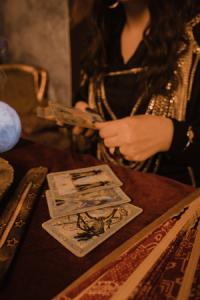 What are tarot cards?
What are tarot cards?
Tarot (teh-row) cards are a set of cards, usually consisting of 78 cards, designed and used to perform tarot readings. These 78 cards are divided into Major Arcana (22 cards) and Minor Arcana (56 cards). The Minor Arcana are divided into four suits—Cups, Pentacles, Swords and Wands (14 cards each).
These cards evolved from playing cards used in the mid-1400s in Italy, France and surrounding areas. In the late 1700s, regular playing cards became an established medium for divination. Jean-Baptiste Alliette is known as the first to develop a consistent interpretation and concept for tarot cards and their meaning, publishing his own deck in 1789.
What do tarot readings do?
Tarot readings mean different things to different individuals. Some people believe they tell the future, others think they are a connection to other worlds, and some say that tarot readings prompt deeper personal reflection.
Pick a Deck
The first step in performing a tarot reading is to pick a deck. There are hundreds of different decks designed by many people. Each of these decks is unique and can be interpreted in different ways based on its artwork.
Each card has a standard general meaning while the art and theme of each deck may alter its interpretation slightly. While minimalist decks look beautiful, they can be harder to read because they give you less to work with in their imagery.
The most well-known and basic deck is Rider-Waite’s deck. This is a very traditional deck but provides a lot to work with in the art. There are other starter decks that come with booklets to help give more context to each card. Even experienced readers will reference these books when using a new deck.
 Learn the Cards
Learn the Cards
Major Arcana
Major Arcana cards represent big overarching life lessons, worldly karmic influences, and the big themes that are influencing your life. The Major Arcana card meanings can get very deep and complex. They signify forceful influences that may be exerted on you, positive or negative, that you should be aware of.
Minor Arcana
Minor Arcana are made up of the Ace, cards two-10, the Page (or knave), Knight, Queen and King. Each suit is connected to an aspect of life. There are many different ways to define these meanings, but they all run through a similar vein.
- Suit Cups: water, emotions and relationships, heart.
- Suit Pentacles: earth, property and achievement, material and physical, finances and career.
- Suit Swords: air, wisdom and communication, conflict and strife, intellect and logic.
- Suit Wands: fire, passion and inspiration, spiritual and movement, growth and new beginnings, creativity and instinct.
How to Do a Reading
It is recommended to get comfortable with your cards by pulling one every day. This will help you get familiar with what each card looks like and could mean as well as how they relate to you. Revisiting this card at the end of the day can help inform you of what this card was trying to express.
Start by centering yourself and clearing your mind, creating space to focus. It is important to come to a reading with an open and trusting mind to be able to explore your question. Reading cards is all about interpreting the meaning of each card and how it relates to your goal.
When asking a question, settle on a topic or point of reflection. It is best to ask open-ended questions as "yes" or "no" questions do not have clear answers in the deck. However, you could assign a card to mean "yes" and a card to mean "no". It is also best to break questions up into individual parts. You could also ask the cards for inspiration regarding a specific part of your life.
There are many different spreads that can be used depending on the extent of the question and/or answer you are pursuing. The best starting spread is the three-card spread. This spread creates a story of past, present and future. It can also create a situation, obstacle and advice thread as well as a mind, body and spirit connection. Focusing on how the past and present can inform choices for the future will give you a better idea on how to approach something you aren’t sure what to ask about. There are many different spreads from one card to using the whole deck.
After selecting the question and spread, you must then focus on your question, point of reflection, or topic you wish to investigate or gain insight into. Sit with your deck until you are ready to shuffle. Shuffle until you feel it is time to stop and pick the number of cards you chose for your spread. You can pick the cards from anywhere in your deck—whatever cards feel right.
As you select each card, take some time to theorize about what it could be expressing to you. Continue to pull cards and lay them out in the spread while thinking about the story they could be trying to tell you. After you have laid out all the cards, take a look at them together and individually to try and discern their meaning, referring to any guides you use. These guides can be found online, and some decks may also come with their own.



Add a comment to: Tarot for Beginners